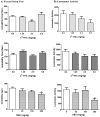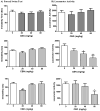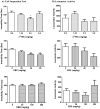Antidepressant-like effect of delta9-tetrahydrocannabinol and other cannabinoids isolated from Cannabis sativa L
- PMID: 20332000
- PMCID: PMC2866040
- DOI: 10.1016/j.pbb.2010.03.004
Antidepressant-like effect of delta9-tetrahydrocannabinol and other cannabinoids isolated from Cannabis sativa L
Abstract
The antidepressant action of cannabis as well as the interaction between antidepressants and the endocannabinoid system has been reported. This study was conducted to assess the antidepressant-like activity of Delta(9)-THC and other cannabinoids. Cannabinoids were initially evaluated in the mouse tetrad assay to determine doses that do not induce hypothermia or catalepsy. The automated mouse forced swim (FST) and tail suspension (TST) tests were used to determine antidepressant action. At doses lacking hypothermic and cataleptic effects (1.25, 2.5, and 5 mg/kg, i.p.), both Delta(9)-THC and Delta(8)-THC showed a U-shaped dose response with only Delta(9)-THC showing significant antidepressant-like effects at 2.5 mg/kg (p<0.05) in the FST. The cannabinoids cannabigerol (CBG) and cannabinol (CBN) did not produce antidepressant-like actions up to 80 mg/kg in the mouse FST, while cannabichromene (CBC) and cannabidiol (CBD) exhibited significant effect at 20 and 200mg/kg, respectively (p<0.01). The antidepressant-like action of Delta(9)-THC and CBC was further confirmed in the TST. Delta(9)-THC exhibited the same U-shaped dose response with significant antidepressant-like action at 2.5 mg/kg (p<0.05) while CBC resulted in a significant dose-dependent decrease in immobility at 40 and 80 mg/kg doses (p<0.01). Results of this study show that Delta(9)-THC and other cannabinoids exert antidepressant-like actions, and thus may contribute to the overall mood-elevating properties of cannabis.
Published by Elsevier Inc.
Figures




References
-
- Bisogno T, Hanus L, De Petrocellis L, Tchilibon S, Ponde D, Brandi I, Moriello AS, Davis JB, Mechoulam R, Di Marzo V. Molecular targets for cannabidiol and its synthetic analogs: effect on vanilloid VR1 receptors and on the cellular uptake and enzymatic hydrolysis of anandamide. Br J Pharmacol. 2001;134:845–52. - PMC - PubMed
-
- Bovassa GB. Cannabis abuse as a risk factor for depressive symptoms. Am J Psychiatry. 2001;158:2033–37. - PubMed
Publication types
MeSH terms
Substances
Grants and funding
LinkOut - more resources
Full Text Sources
Other Literature Sources
Medical
Research Materials
Miscellaneous

